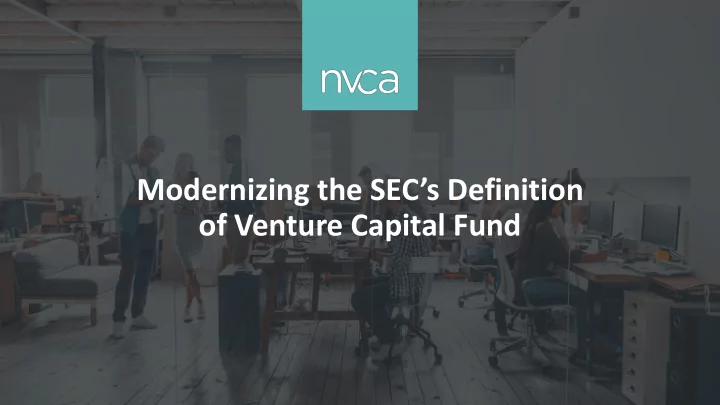

Modernizing the SEC’s Definition of Venture Capital Fund
Background on SEC’s VC Fund Definition Where it Came From: • Dodd-Frank eliminated the exemption from registration for investment advisors with fewer than 15 clients, thus forcing hedge funds and private equity funds to become registered investment advisors (RIAs). • BUT, Congress specifically exempted venture capital funds from the requirement, allowing them to register as exempt reporting advisors (ERAs). • Directed the SEC to create definition of “venture capital fund” to determine who qualifies for ERA status.
Venture Capital’s Vital Role in Startup Growth GROWTH EARLY DEVELOPMENT IDEA / START-UP LATE STAGE VENTURE EARLY STAGE VC SEED/ANGEL INVESTOR • BUILD TEAM & Co. • CONCEPT -> PRODUCT • SCALE Co. -> EXIT • MARKET RISK • PRODUCT RISK • EXIT RISK • LARGER CASH NEED • SMALL CASH NEED • HIGH CASH NEED • NO REVENUE • NO PROFITS • PATH TO PROFITS
Policy Reasons for Exempt Exemption demonstrates that VC funds were never intended target of this Reporting Advisor Status regulation: Long-term equity Because of the economic investment VC model low impact of VC activity on priority for regulation: VC innovation and new funds rarely take control company growth, Congress positions in companies, decided that the policy portfolio company fees priority for VC regulation don’t support returns, should be on making capital leverage not prominent in available for startup activity financings. rather than compliance. Founder + VC = Growth
What Does it Mean to be ERA? Exempt Reporting Advisors register with the SEC under a more limited compliance and reporting regime, which simplifies and reduces the costs of running a venture capital fund. • Reduced compliance costs due to: • Limited form ADV filing; • No form PF requirements; • No routine audits, though still subject to for cause examinations; • No additional cost of RIA compliance program. • Greater freedom of external communications as advertising rule not applicable. • Also not subject to custody or bookkeeping rules, further reducing costs and complexity of VC fund management.
Annual Compliance Costs: ERA vs RIA Total Annual Compliance Costs for Fiscal Year 2016 by Median Compliance Costs for Fiscal Year 2016 by Select Category ERA/RIA ERA/RIA Designation • Software and systems licensing fees & vendor costs: $3,500/$10,000 • Legal costs: $13,000/$42,500 • Compensation related to staff compliance efforts: $28,500/$225,000 • External compliance services: $24,500/$53,500 Source: NVCA Compliance & Financial Reporting Costs Survey, conducted in Fall 2017.
Parameters of SEC’s VC Fund Definition SEC created a multi-factor test to define whether a fund is pursuing a VC strategy, pursuant to Rule 203(l)-1 of the Investment Advisers Act. In order to register as an ERA, a fund must satisfy each factor of the definition: • Representation: Must represent itself as pursuing a venture capital strategy, including in investor and marketing materials; • Leverage limitations: Strict limitations on the use of leverage at the portfolio company and fund levels; • Redemptions: Prohibition on annual redemptions of investors; and • Qualifying investments: At least 80 percent of a fund’s activity must be direct investments into private companies, or “qualifying” investments. Violation of any of these parameters by one fund can trigger an RIA regime for every fund managed by that VC firm.
VC Activities that are “Nonqualifying” Investments • Investments in other VC funds: The creation of more VC funds, particularly in emerging ecosystems, is critical to any effort to expand access to venture capital. And there are few better positioned to support new firms than those already in the business. A manager with regional venture capital experience (e.g. Silicon Valley) may deploy some fund capital to invest in, for example, a Midwestern fund manager who is better positioned to know their market and the players within. But currently, investments into other VC funds are considered nonqualifying investments. • Post-IPO biotech financings: Many biotech firms go public before their product is available for sale. They often rely on VCs and other existing investors for capital infusions to finance the costs of commercialization, including clinical trials, research and hiring. But because these are currently considered nonqualifying investments, VC funds must limit the amount of capital they can provide to their public portfolio companies. • Secondary investments: Because acquiring secondary shares are considered nonqualifying investments, VC funds are discouraged from providing angel and seed stage investors and founders liquidity. As companies have stayed private longer, path to liquidity has become a significant issue in the venture capital industry.
Modernizing the definition of “Qualifying” Investments • Allow VC funds to invest in other VC funds, thus better capitalizing regional funds to enable them to invest in companies within their territories. Many companies in these regions are overlooked by the coastal funds. • Allow VC funds to make follow-on direct investments in portfolio companies that go public.
Recommend
More recommend